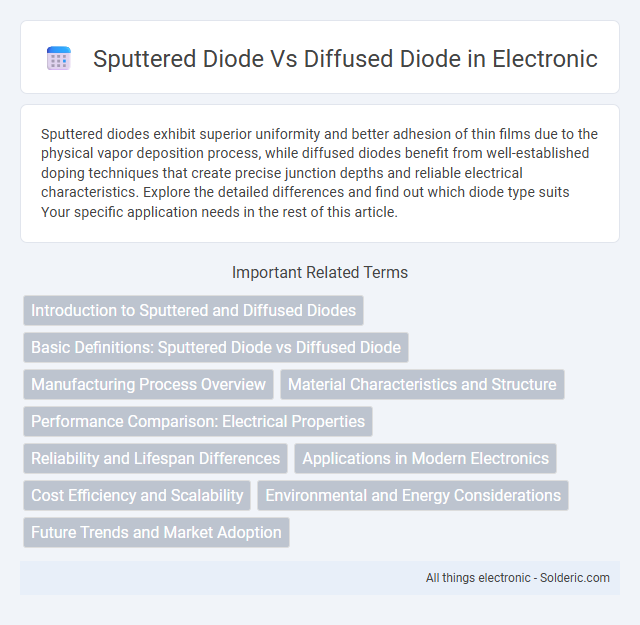Sputtered diodes exhibit superior uniformity and better adhesion of thin films due to the physical vapor deposition process, while diffused diodes benefit from well-established doping techniques that create precise junction depths and reliable electrical characteristics. Explore the detailed differences and find out which diode type suits Your specific application needs in the rest of this article.
Comparison Table
| Feature | Sputtered Diode | Diffused Diode |
|---|---|---|
| Manufacturing Process | Thin film deposited by sputtering onto the substrate | Impurities diffused into semiconductor substrate at high temperature |
| Junction Formation | Physical deposition creates PN junction | Thermal diffusion forms PN junction |
| Thickness | Typically thinner, nanometer-scale | Thicker, micrometer-scale layer |
| Precision | High precision in layer control | Less precise diffusion profile |
| Speed of Fabrication | Faster process with sputtering | Slower, requires long diffusion times |
| Electrical Characteristics | Lower leakage current, better high-frequency response | Higher leakage current, limited frequency response |
| Applications | High-speed switching, RF circuits | General-purpose rectifiers, power diodes |
| Cost | Higher cost due to advanced equipment | Lower cost, established manufacturing |
Introduction to Sputtered and Diffused Diodes
Sputtered diodes are fabricated using a physical vapor deposition process where a thin film of semiconductor material is deposited onto a substrate, creating precise and uniform diode layers. Diffused diodes are produced by introducing dopants into the semiconductor substrate through high-temperature diffusion, forming junctions with altered electrical properties. Understanding the differences in manufacturing techniques helps you select the diode type best suited for specific electronic applications requiring distinct performance characteristics.
Basic Definitions: Sputtered Diode vs Diffused Diode
Sputtered diodes are created using physical vapor deposition where thin films of semiconductor material are deposited onto a substrate through sputtering, resulting in precise control over layer thickness and uniformity. Diffused diodes are formed by introducing dopants into the semiconductor substrate at high temperatures, causing the dopants to diffuse and create the p-n junction. Your choice between sputtered diode and diffused diode depends on the required manufacturing precision, cost, and device performance in applications.
Manufacturing Process Overview
Sputtered diodes are manufactured by sputtering thin films of semiconductor material onto a substrate using ionized gas plasma, enabling precise control over layer thickness and uniformity. Diffused diodes involve introducing dopants into the semiconductor substrate through high-temperature diffusion, creating a gradual concentration gradient that forms the p-n junction. The sputtering process offers lower thermal stress and faster deposition, while diffusion requires longer heat treatments but ensures deeper dopant penetration and robust junction formation.
Material Characteristics and Structure
Sputtered diodes feature a thin, uniform semiconductor layer deposited through physical vapor deposition, resulting in superior surface smoothness and enhanced control over material properties compared to diffused diodes. Diffused diodes are formed by introducing dopants into the semiconductor substrate via thermal diffusion, creating a graded junction with deeper penetration but less precise control over layer thickness. Understanding these material characteristics and structural differences helps optimize your device's performance in terms of response time, leakage current, and breakdown voltage.
Performance Comparison: Electrical Properties
Sputtered diodes typically exhibit lower series resistance and faster switching speeds due to the thin, uniform metal layers deposited by sputtering, enhancing high-frequency performance. Diffused diodes often have higher breakdown voltages and better thermal stability because of the gradual junction profiles created during the diffusion process. Overall, sputtered diodes are preferred in applications requiring rapid response times, while diffused diodes excel in high-power and high-temperature environments.
Reliability and Lifespan Differences
Sputtered diodes generally exhibit higher reliability under harsh environmental conditions due to their dense and uniform thin films, resulting in enhanced resistance to thermal and mechanical stress. Diffused diodes, while offering stable performance in controlled environments, often experience shorter lifespans caused by potential dopant diffusion and junction degradation over time. The superior adhesion and reduced defect rates in sputtered diodes contribute to extended operational lifespan compared to diffused counterparts.
Applications in Modern Electronics
Sputtered diodes are primarily used in high-frequency and high-speed applications due to their precise thin-film layers and superior junction uniformity, making them ideal for RF circuits and microwave devices. Diffused diodes, with their robust construction and excellent thermal stability, are commonly employed in power rectification and voltage regulation in power supplies and analog circuits. Both diode types are crucial in modern electronics, with sputtered diodes favoring signal processing roles and diffused diodes excelling in power and general-purpose applications.
Cost Efficiency and Scalability
Sputtered diodes generally offer higher cost efficiency in mass production due to their compatibility with automated, large-scale fabrication processes, reducing per-unit expenses. Diffused diodes involve higher material and processing costs because of the longer thermal cycles and specialized equipment required, limiting scalability for volume manufacturing. Your choice depends on balancing initial investment and production volume, with sputtered diodes favoring scalable, cost-effective solutions in high-demand markets.
Environmental and Energy Considerations
Sputtered diodes typically offer better environmental sustainability due to their low-temperature fabrication process, which reduces energy consumption compared to the high-temperature diffusion method used in diffused diodes. The sputtering technique also minimizes hazardous chemical usage and waste, aligning with eco-friendly production standards. Your choice of diode technology can significantly impact the overall environmental footprint and energy efficiency of semiconductor device manufacturing.
Future Trends and Market Adoption
Sputtered diodes are gaining traction due to their superior thin-film deposition techniques, enabling higher efficiency and scalability in semiconductor manufacturing. Diffused diodes, while established and cost-effective, face limitations in miniaturization and performance enhancements compared to sputtered counterparts. Your choice of diode technology will influence adaptability to emerging industry demands, with sputtered diodes poised for significant growth in high-frequency and power applications.
Sputtered diode vs Diffused diode Infographic

 solderic.com
solderic.com